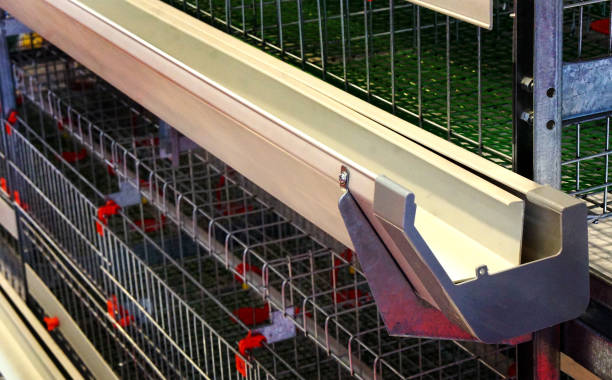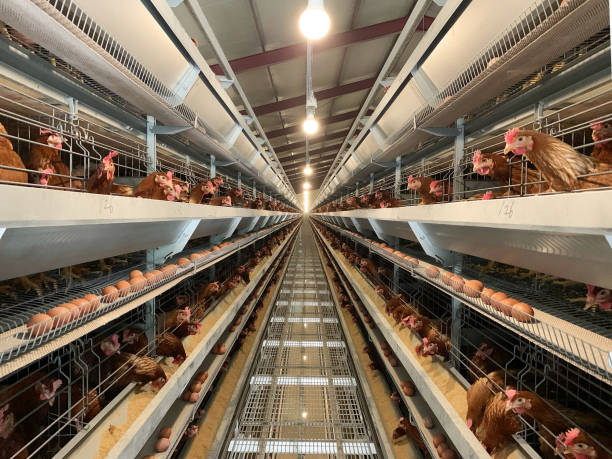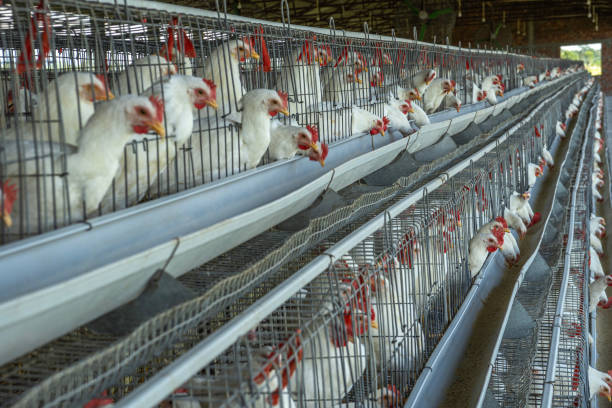
Layer Battery Cages in Uganda: A Profitable Poultry Farming Project
Layer Battery Cages in Uganda: A Profitable Poultry Farming Project
For aspiring poultry entrepreneurs in Uganda, the adoption of layer battery cages represents a pathway to building a profitable and sustainable poultry farming project. While traditional free-range methods may conjure idyllic images, in the context of modern commercial egg production, battery cages offer significant advantages in terms of efficiency, biosecurity, and overall profitability. This article delves into the intricacies of layer battery cages in the Ugandan poultry landscape, exploring their benefits, implementation strategies, economic considerations, and providing practical advice for farmers looking to embrace this modern farming technique.
Understanding Layer Battery Cages
Layer battery cages are a housing system specifically designed for egg-laying hens. They consist of rows of tiered cages, typically made of galvanized steel wire mesh, each housing a small group of hens. These cages are designed to provide a controlled environment that optimizes egg production and simplifies management. Key features of layer battery cages contributing to their effectiveness include:
Optimized space utilization: Battery cages maximize space by housing a larger number of hens in a given area compared to free-range or deep litter systems. This is particularly crucial in Uganda where land costs can be a limiting factor for farmers.
Improved hygiene: The wire mesh floors allow manure to drop through, minimizing contact between the hens and their waste. This reduces the risk of disease outbreaks and improves overall flock health.
Easier egg collection: Eggs roll onto a collection tray, simplifying egg collection and reducing egg breakage. This saves time and labor costs for farmers.
Individual monitoring: Battery cages facilitate individual monitoring of hens, allowing farmers to quickly identify and address health issues or variations in egg production.
Controlled Environment: By enclosing the chickens in a separated environment, farmers minimize the disturbance by external environment.
The Benefits of Layer Battery Cages in Uganda
The adoption of layer battery cages offers several significant benefits for poultry farmers in Uganda:
Increased Egg Production: Battery cages provide a controlled environment that optimizes egg production. The hens are protected from predators, extreme weather conditions, and competition for resources, which reduces stress and increases laying efficiency. Studies have shown that hens in battery cages often produce more eggs per year compared to hens in alternative systems.
Reduced Disease Risk: The improved hygiene and controlled environment of battery cages significantly reduce the risk of disease outbreaks. This translates to lower mortality rates, reduced veterinary costs, and improved flock health. The biosecurity benefits are especially relevant in Uganda, where poultry diseases can be a major challenge for farmers.

Improved Feed Efficiency: Battery cages minimize feed wastage, as the hens have limited movement and less opportunity to scatter feed. This improves feed conversion ratios, meaning that farmers can produce more eggs with less feed, leading to significant cost savings. Specifically, farmers can monitor the food intake and overall health condition of each hen, which allows them to better adjust the diet regime of the flock in the long run.
Labor Efficiency: The automated egg collection and manure removal systems associated with battery cages significantly reduce labor requirements. This is particularly beneficial for larger-scale poultry operations, allowing farmers to manage their flocks more efficiently.
Enhanced Egg Quality: Battery cages help to maintain egg quality by minimizing contact with manure and reducing the risk of contamination. The eggs are cleaner, have a lower risk of bacterial contamination, and often command a higher price in the market.
Predator Protection: Free-range poultry farms are vulnerable to predators, such as foxes, birds of prey, and even stray dogs. Battery cages provide a secure environment that protects hens from predators, reducing losses and improving overall flock security.
Implementing Layer Battery Cages in Uganda
Successfully implementing layer battery cages in Uganda requires careful planning and execution. Here’s a step-by-step guide:

Market Research: Conduct thorough market research to understand the demand for eggs in your target market. Identify your potential customers, assess the competition, and determine the price you can realistically expect to receive for your eggs.
Business Plan: Develop a comprehensive business plan that outlines your goals, strategies, and financial projections. This will help you secure funding, track your progress, and make informed decisions.
Site Selection: Choose a suitable site for your poultry farm. Consider factors such as proximity to markets, availability of water and electricity, access to transportation, and biosecurity considerations. The location should be relatively isolated to minimize the risk of disease transmission from other farms.
Cage Selection and Installation: Select high-quality layer battery cages from a reputable supplier. Prioritize cages that are durable, easy to clean, and designed for optimal hen welfare. Ensure that the cages are properly installed and that the ventilation, lighting, and feeding systems are functioning correctly. Livi Machinery is a reputable supplier of layer battery cages, serving numerous poultry farms across Africa.
Flock Selection: Choose a breed of layer hen that is well-suited to the Ugandan climate and market conditions. Consider factors such as egg production, egg size, feed efficiency, and disease resistance. Purchase your chicks from a reputable hatchery that guarantees the health and quality of the birds.
Feeding and Watering: Provide your hens with a balanced diet that meets their nutritional needs. Ensure that they have access to fresh, clean water at all times. Work with a qualified nutritionist to develop a feeding program that optimizes egg production and hen health.
Health Management: Implement a comprehensive health management program to prevent and control diseases. This should include regular vaccinations, deworming, and biosecurity measures. Consult with a veterinarian to develop a customized health plan for your flock.
Manure Management: Develop a plan for managing manure effectively. Manure can be used as fertilizer for crops or processed into biogas. Proper management of manure is essential for environmental sustainability and biosecurity.
Record Keeping: Maintain detailed records of egg production, feed consumption, mortality rates, and other relevant data. This will help you track your performance, identify problems, and make informed decisions.
Economic Considerations
The economic viability of a layer battery cage project in Uganda depends on several factors, including:
Initial Investment: The initial investment includes the cost of land, cages, chicks, feeding and watering equipment, and other infrastructure.
Operating Costs: Operating costs include feed, labor, veterinary care, electricity, and other expenses.
Egg Prices: Egg prices fluctuate depending on market conditions, seasonality, and quality.
Production Efficiency: Production efficiency is measured by factors such as egg production per hen, feed conversion ratio, and mortality rates.
A detailed financial analysis is essential to determine the profitability of your project. This should include projections of revenues, expenses, and cash flow. Secure funding from banks, microfinance institutions, or other sources. Government programs in Uganda also provides assistance.
Challenges and Solutions
While layer battery cages offer numerous benefits, poultry farmers in Uganda may face certain challenges:
High Initial Investment: The initial investment in cages and equipment can be a barrier for some farmers. Solutions: Explore financing options, such as loans or grants. Consider starting with a smaller-scale operation and expanding gradually.
Feed Costs: Feed costs can be a significant expense. Solutions: Optimize feed formulation, improve feed management practices, and explore alternative feed ingredients.
Disease Outbreaks: Disease outbreaks can cause significant losses. Solutions: Implement strict biosecurity measures, vaccinate your flock regularly, and consult with a veterinarian promptly if you suspect a disease outbreak.
Market Fluctuations: Egg prices can fluctuate due to seasonal changes and market conditions. Solutions: Develop a marketing strategy that includes diversifying your customer base, exploring value-added products, and negotiating contracts with buyers.
Access to Information: Insufficient access to information on best practices. Solutions: Attend training workshops, consult with agricultural extension officers, and network with other poultry farmers.
Power Outages: Frequent power outages can disrupt operations. Solutions: Invest in a backup generator to ensure a continuous power supply for critical equipment.

Conclusion
Layer battery cages represent a viable and profitable poultry farming project for entrepreneurs in Uganda. By adopting this modern farming technique, farmers can increase egg production, reduce disease risk, improve feed efficiency, and enhance egg quality. Successful implementation requires careful planning, investment in high-quality cages and equipment, and adherence to best management practices. While challenges exist, they can be overcome with proper strategies and support. With dedication and hard work, poultry farmers in Uganda can build thriving businesses that contribute to food security and economic development. By embracing layer battery cages, Ugandan farmers can unlock the full potential of their poultry operations and achieve long-term success in the egg production industry. The efficiency, biosecurity, and profitability offered by layer battery cages make them a compelling choice for aspiring poultry entrepreneurs looking to establish a sustainable and rewarding farming project in Uganda.
